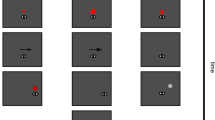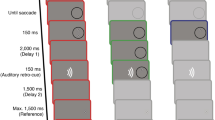Abstract
Adaptation of saccade gains in response to errors keeps vision and action co-registered in the absence of awareness or effort. Timing is key, as the visual error must be available shortly after the saccade is generated or adaptation does not occur. Here, we tested the hypothesis that when feedback is delayed, learning still occurs, but does so through small secondary corrective saccades. Using a memory-guided saccade task, we gave feedback about the accuracy of saccades that was falsely displaced by a consistent amount, but only after long delays. Despite the delayed feedback, over time subjects improved in accuracy toward the false feedback. They did so not by adjusting their primary saccades, but via directed corrective saccades made before feedback was given. We propose that saccade learning may be driven by different types of feedback teaching signals. One teaching signal relies upon a tight temporal relation with the saccade and contributes to obligatory learning independent of awareness. When this signal is ineffective due to delayed error feedback, a second compensatory teaching signal enables flexible adjustments to the spatial goal of saccades and helps maintain sensorimotor accuracy.





Similar content being viewed by others
References
Albus JS (1971) A theory of cerebellar function. Math Biosci 10:25–61
Bahcall DO, Kowler E (2000) The control of saccadic adaptation: implications for the scanning of natural visual scenes. Vision Res 40:2779–2796
Becker W (1989) Metrics. In: Wurtz RH, Goldberg ME (eds) The neurobiology of saccadic eye movements. Elsevier, New York, pp 13–67
Braun D, Weber H, Mergner T, Schulte-Monting J (1992) Saccadic reaction times in patients with frontal and parietal lesions. Brain 115(Pt 5):1359–1386
Cheng S, Sabes PN (2006) Modeling sensorimotor learning with linear dynamical systems. Neural Comput 18:760–793
Curtis CE (2006) Prefrontal and parietal contributions to spatial working memory. Neuroscience 139:173–180
Curtis CE, D’Esposito M (2004) The effects of prefrontal lesions on working memory performance and theory. Cogn Affect Behav Neurosci 4:528–539
Deubel H (1995) Separate adaptive mechanisms for the control of reactive and volitional saccadic eye movements. Vision Res 35:3529–3540
Deubel H (1999) Separate mechanisms for the adaptive control of reactive, volitional, and memory-guided saccadic eye movements. In: Gopher D, Koriat A (eds) Attention and performance XVII cognitive regulation of performance: interaction of theory and application. MIT Press, Cambridge, pp 697–721
Dias EC, Segraves MA (1999) Muscimol-induced inactivation of monkey frontal eye field: effects on visually and memory-guided saccades. J Neurophysiol 81:2191–2214
Diedrichsen J, Hashambhoy Y, Rane T, Shadmehr R (2005) Neural correlates of reach errors. J Neurosci 25:9919–9931
Donchin O, Francis JT, Shadmehr R (2003) Quantifying generalization from trial-by-trial behavior of adaptive systems that learn with basis functions: theory and experiments in human motor control. J Neurosci 23:9032–9045
Fischer B, Weber H, Biscaldi M, Aiple F, Otto P, Stuhr V (1993) Separate populations of visually guided saccades in humans: reaction times and amplitudes. Exp Brain Res 92:528–541
Frens MA, van Opstal AJ (1994) Transfer of short-term adaptation in human saccadic eye movements. Exp Brain Res 100:293–306
Fujita M, Amagai A, Minakawa F, Aoki M (2002) Selective and delay adaptation of human saccades. Brain Res Cogn Brain Res 13:41–52
Hopp JJ, Fuchs AF (2002) Investigating the site of human saccadic adaptation with express and targeting saccades. Exp Brain Res 144:538–548
Hopp JJ, Fuchs AF (2004) The characteristics and neuronal substrate of saccadic eye movement plasticity. Prog Neurobiol 72:27–53
Kawato M (1999) Internal models for motor control and trajectory planning. Curr Opin Neurobiol 9:718–727
Li CS, Mazzoni P, Andersen RA (1999) Effect of reversible inactivation of macaque lateral intraparietal area on visual and memory saccades. J Neurophysiol 81:1827–1838
Marr D (1969) A theory of cerebellar cortex. J Physiol Lond 202:437–470
Mauk MD, Medina JF, Nores WL, Ohyama T (2000) Cerebellar function: coordination, learning or timing? Curr Biol 10:R522–R525
Mazzoni P, Krakauer JW (2006) An implicit plan overrides an explicit strategy during visuomotor adaptation. J Neurosci 26:3642–3645
McLaughlin S (1967) Parametric adjustment in saccadic eye movements. Percept Psychophys 2:359–362
Murthy A, Ray S, Shorter SM, Priddy EG, Schall JD, Thompson KG (2007) Frontal eye field contributions to rapid corrective saccades. J Neurophysiol 97:1457–1469
Ohyama T, Nores WL, Murphy M, Mauk MD (2003) What the cerebellum computes. Trends Neurosci 26:222–227
Pierrot-Deseilligny C, Rivaud S, Gaymard B, Muri R, Vermersch AI (1995) Cortical control of saccades. Ann Neurol 37:557–567
Pierrot-Deseilligny C, Milea D, Muri RM (2004) Eye movement control by the cerebral cortex. Curr Opin Neurol 17:17–25
Ploner CJ, Rivaud-Pechoux S, Gaymard BM, Agid Y, Pierrot-Deseilligny C (1999) Errors of memory-guided saccades in humans with lesions of the frontal eye field and the dorsolateral prefrontal cortex. J Neurophysiol 82:1086–1090
Smith AC, Frank LM, Wirth S, Yanike M, Hu D, Kubota Y, Graybiel AM, Suzuki WA, Brown EN (2004) Dynamic analysis of learning in behavioral experiments. J Neurosci 24:447–461
Srimal R, Diedrichsen J, Ryklin EB, Curtis CE (2008) Obligatory adaptation of saccade gains. J Neurophysiol 99:1554–1558
Thier P, Dicke PW, Haas R, Barash S (2000) Encoding of movement time by populations of cerebellar Purkinje cells. Nature 405:72–76
Thoroughman KA, Shadmehr R (2000) Learning of action through adaptive combination of motor primitives. Nature 407:742–747
Wolpert DM, Kawato M (1998) Multiple paired forward and inverse models for motor control. Neural Netw 11:1317–1329
Acknowledgments
We thank Edward Ryklin for technical assistance and Josh Wallman and Mark Harwood for critical discussions. This work was supported by grants from the NIH R01 EY016407.
Author information
Authors and Affiliations
Corresponding author
Additional information
An erratum to this article can be found at http://dx.doi.org/10.1007/s00221-010-2533-7
Rights and permissions
About this article
Cite this article
Srimal, R., Curtis, C.E. Secondary adaptation of memory-guided saccades. Exp Brain Res 206, 35–46 (2010). https://doi.org/10.1007/s00221-010-2394-0
Received:
Accepted:
Published:
Issue Date:
DOI: https://doi.org/10.1007/s00221-010-2394-0




